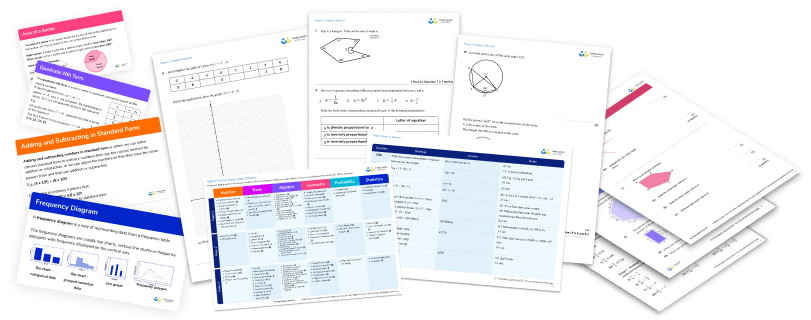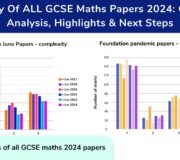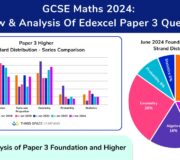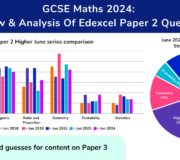GCSE Results 2023: Information And Next Steps For Teachers And School Leaders
GCSE results 2023 have been released! Our resident secondary expert, Christine Norledge, has guided us through this years’ busy exam series. In this blog, she’ll finish the series with a thorough analysis of this year’s GCSE results 2023 and our key findings this year.
It’s been a slow return to normal following the learning disruption caused by the Covid pandemic, but this year we’ve had the first round of GCSE summer exams without significant adaptations or allowances made for lost learning time.
This year, the exams took place throughout May and June of 2023. Young people up and down the country received their GCSE exam results on 24th August 2023.
Unless otherwise stated, figures in this article are for 16-year olds in England. Data from Wales, Scotland and Northern Ireland is excluded.
Statistics on teacher opinions come from a survey conducted by Third Space Learning in August 2023.
This blog takes a look at some of the stories from GCSE results day on Thursday 24 August 2023. We’ll consider:
- How grade boundaries were set this year;
- What this means for future examination series;
- How students’ and teachers’ experiences of the Edexcel GCSE maths papers are reflected in the results achieved;
- How you can use your maths results to plan for the upcoming year.
GCSE Revision Lists Foundation & Higher
Download these revision lists to support your students and their revision. Includes dedicated Foundation and Higher lists, with links to our collection of free downloadable resources!
Download Free Now!Stay updated for 2024 GCSE season
Join our email list to be alerted to any new changes to GCSE maths exams in 2024.
We’ve got all the GCSE dates 2024 and we will be reviewing the contents of each of the GCSE maths papers in 2024 and taking a good look at the GCSE results 2024 in August.
Take a look at GCSE Maths Paper 1 2024 Analysis And Revision Topic List
The headlines: results are down on 2022, but remain higher than 2019
As expected, results continued the downward trajectory from the peaks in 2020/21.
Results were lower than in 2022, which was expected this year, but remained slightly higher than 2019 (the last set of summer GCSE exams before the Covid pandemic). The exam regulator Ofqual has stated that it is most meaningful this year to make comparisons to 2019’s data.
For 16-year olds in England, 70.3% of all GCSEs across all subjects were awarded the ‘pass’ mark, grade 4, or above. The 4+ pass rate for all GCSEs for all ages in England was 67.8%.
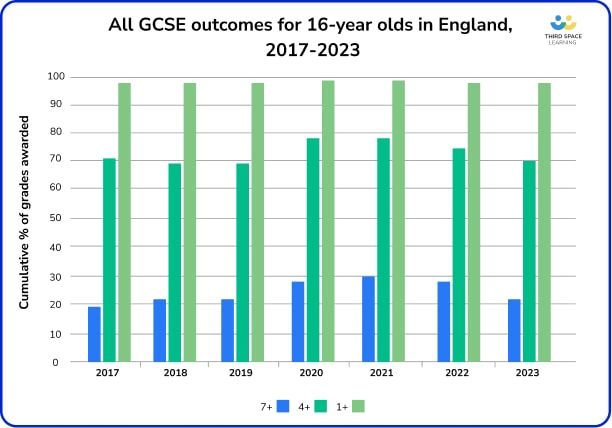
The following headline information applies to all GCSEs in all subjects for 16-year olds in England.
GCSE students achieving a grade 1 or above:
- The proportion of grade 1+ awarded has fallen slightly by 0.5 percentage points to 98.1%;
- This is now lower than 2018-2019 figures of 98.5%, and is the lowest in the history of the specification.
GCSE students achieving grade 4 or above (commonly referred to as a ‘pass’):
- The proportion of grade 4+ awarded has dropped by 5 percentage points to 70.3%;
- This remains slightly higher than in 2019 (69.9%).
GCSE students achieving the top GCSE grades (grade 7 or above):
- The proportion of grade 7+ awarded has decreased by 4.6 percentage points to 22.4%;
- This remains slightly higher than in 2019 (21.8%).
GCSE maths outcomes: headline figures
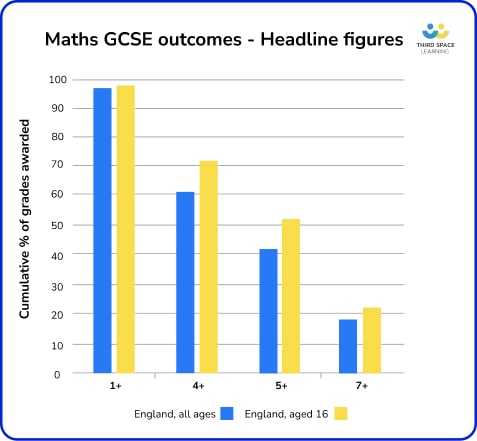

For 16-year olds in England in 2023:
- The proportion of grade 1+ awarded in maths has fallen very slightly by 0.2 percentage points from 2022 and identical to the 2019 figure.
- The proportion of grade 4+ awarded in maths has dropped by 2.8 percentage points to 72.3%, and is now much closer to the 2019 figure of 71.5%.
- The proportion of top grades (7+) awarded in maths has dropped by 2.9 percentage points – 21.1% of candidates were awarded grade 7 or higher, slightly higher than the 2019 figure of 20.4%.
Bigger picture: headline results for other GCSE subjects
At Third Space Learning, we’re maths specialists, so this article focuses primarily on the 2023 maths GCSE exams and results. Here are a few highlights from other subjects:
English language and literature
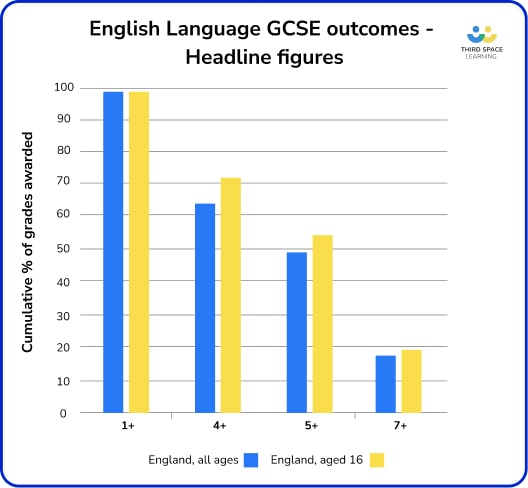

In comparison with 2022, the percentage of candidates achieving grade 4+ or grade 7+ has decreased in maths, English language and English literature.
This decrease is greatest in English language – this is perhaps not surprising, as the increase in 4+ and 7+ passes in English language was almost double the increases in literature and maths last year.
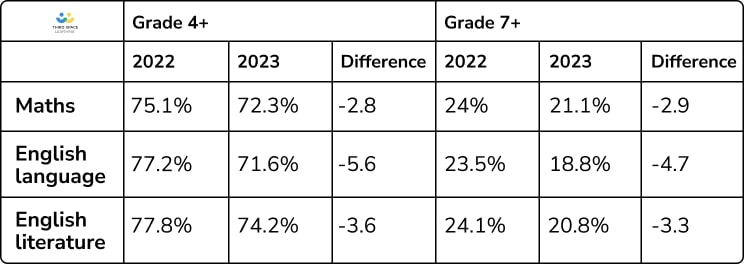
In maths and English language, results are still around 1 percentage point higher than 2019. In English literature, results are only 0.1 percentage point higher.
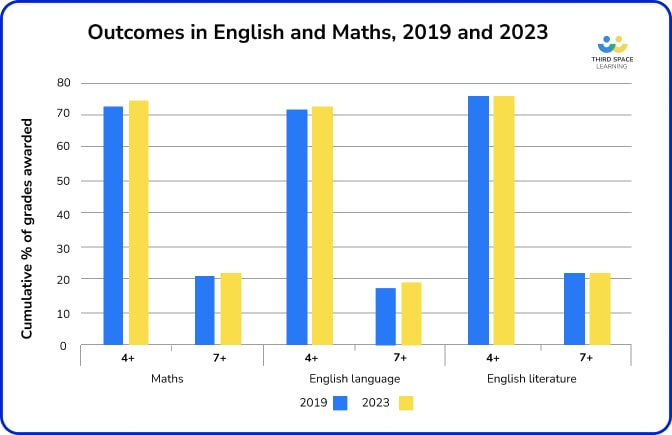
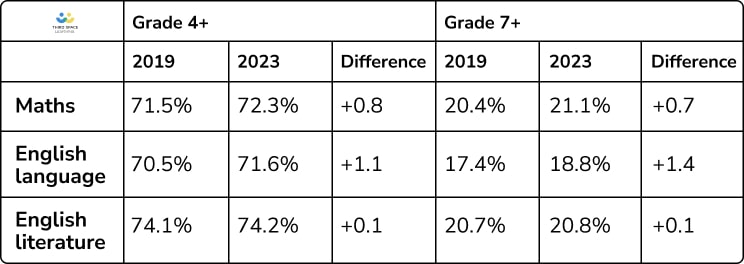
Modern foreign languages
This year, uplifts were applied to grades 9, 7 and 4 in French and German; these adjustments were made to better align outcomes in French and German with Spanish.
Grades in all three MFL subjects have dropped sharply this year.

Science
In Double Award Science last year, the proportion of 4-4 and above grades was up 5 percentage points from 2019 to 60.5%, and the proportion of grade 7-7 and above was up 2.8 percentage points to 10.3%. This year, results have fallen back by 3.9 and 1.8 percentage points respectively, and are much closer to 2019’s results.

Maths GCSE results 2023 adjustments and grade boundaries
This year, we have continued the trajectory back to normal with the full syllabus assessed, no advance information and a return to pre-pandemic grading. Access to a maths formula sheet has continued for 2023 only.
In 2022, the way that GCSE grade boundaries were set was changed slightly, and results reflected a ‘midpoint’ between the last set of summer public exams (2019) and teacher assessments used in summer 2021.
In 2023, this adjustment was removed and grade boundaries were set using pre-pandemic standards, with ‘protection’ built in for the cohort to reflect the disruption they have faced, similar to the protections applied for the first cohorts of students sitting reformed GCSEs and A-levels in 2017.
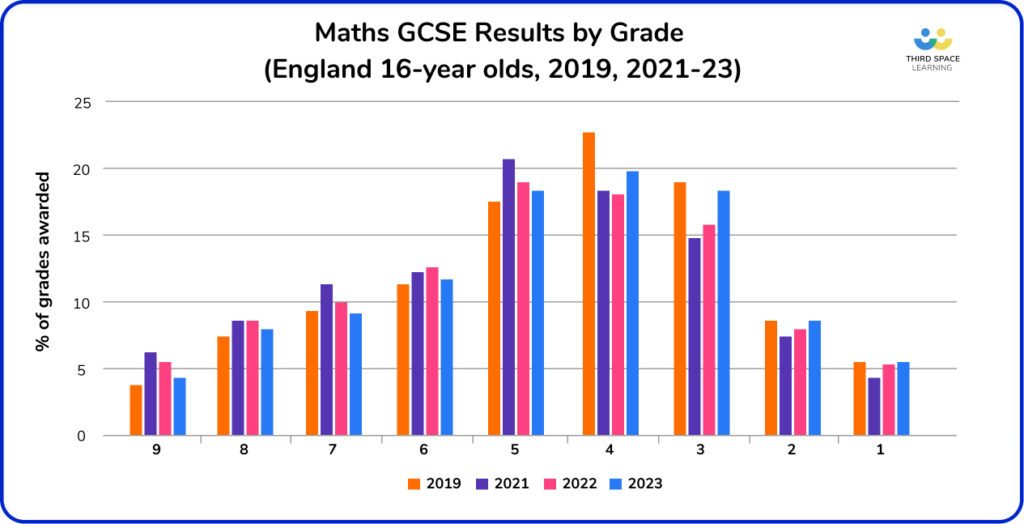
Despite measures to return results closer to pre-pandemic levels, there was still a higher proportion of higher grades (9-5) and a lower proportion of lower grades (4-1) awarded in summer 2022 compared to summer 2019. This was part of a planned gradual return to pre-pandemic grading levels.
This year, the rebalancing has continued, with the proportion of higher grades decreasing and the proportion of lower grades increasing again.
Results generally remain slightly higher in comparison with 2019 – this is potentially due to the protections put in place by Ofqual described above.
We look at the setting of grade boundaries in more detail below.
Pandemic years: GCSE results 2020 – 2022
GCSEs did not take place as usual in 2020 or 2021.
In 2020, Ofqual developed an algorithm to assign GCSE grades. However, in response to controversy over down-grading of A-level results, this model was scrapped by the DfE (Department for Education). Students were given the higher of their centre-assessed grade or calculated grade.
In mathematics that year, the number of students who gained a 7 and above rose from 20% to 24%, and those who gained a 4 and above rose from 71.5% to just above 77%.
In 2021, teacher-assessed grades (TAGs) were awarded using mock exams, in-class tests and other non-exam assessments that had already been completed.
Mathematics results in 2021 were even higher than in 2020, with the proportion of students gaining a 7 and above rising to 25.9%, and those gaining 4 and above rising to nearly 78%.
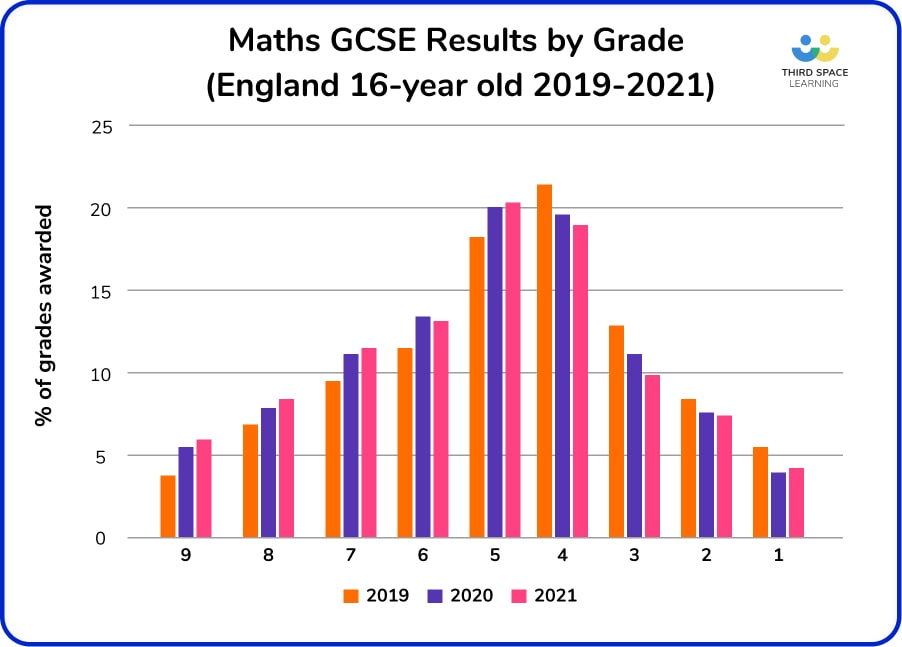
In 2022, exam boards used data from 2019’s exams and 2021’s teacher-assessed grades as a starting point for grading. It was expected that results would reflect a ‘midpoint’ between summer 2019 and summer 2021, easing a downwards trajectory to pre-pandemic levels.
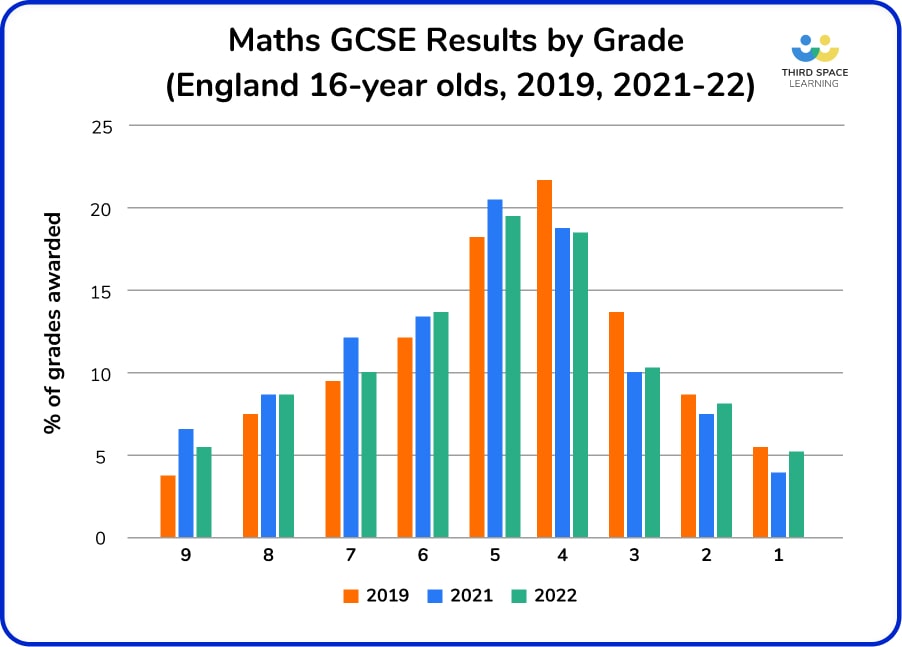
We saw last year in maths that exam boards were more generous in awarding higher grades than the strict midpoint between 2019 and 2021.
We also saw that the benchmark grades 4 and 7 had a lower proportion of grades awarded than the strict midpoint value, reflecting the fact that more students on the 7-8 and 4-5 borderlines were awarded the higher grade on the borderline.
Post-pandemic: Setting the boundaries in 2023
Every year, grade boundaries for GCSE examinations are set once all of the papers have been sat and marking has been completed. Statistical measures including the performance of the cohort at KS2 are used to suggest initial grade boundaries.
GCSE MATHS 2024: STAY UP TO DATE
Join our email list to stay up to date with the latest news, revision lists and resources for GCSE maths 2024. We’re analysing each paper during the course of the 2024 GCSEs in order to identify the key topic areas to focus on for your revision.
Thursday 16th May 2024: GCSE Maths Paper 1 2024 Analysis & Revision Topic List
Monday 3rd June 2024: GCSE Maths Paper 2 2024 Analysis & Revision Topic List
Monday 10th June 2024: GCSE Maths Paper 3 2024 Analysis
GCSE 2024 dates
GCSE 2024 results
GCSE results 2023
This year, additional protection has been put in place to assure that students are not significantly disadvantaged – this protection was previously applied to the first cohort to sit reformed GCSEs in 2017.
Next, the senior examining team looks at scripts from candidates on the borderlines of these boundaries (a couple of marks either side), and compares these scripts to the equivalent awarded grade from the previous year. So, they look to see whether a ‘grade 4’ student’s work from the current series looks and feels the same as the work of a student who was awarded a grade 4 in the previous series of examinations.
Grade boundaries differ from paper to paper, and exam board to exam board. A more difficult paper has lower boundaries than an easier paper, ensuring that it is no easier or harder to get a particular grade with one board than another.
In their July blog, Ofqual stated that:
- National results would be lower this year;
- Most schools and colleges would receive results that are lower than 2022;
- It is most meaningful to compare this year’s data to 2019 when analysing performance trends;
- Marking has happened as normal, in accordance with agreed mark schemes;
- Universities are aware of the grading approach in 2023 and have taken this into account when making offers.
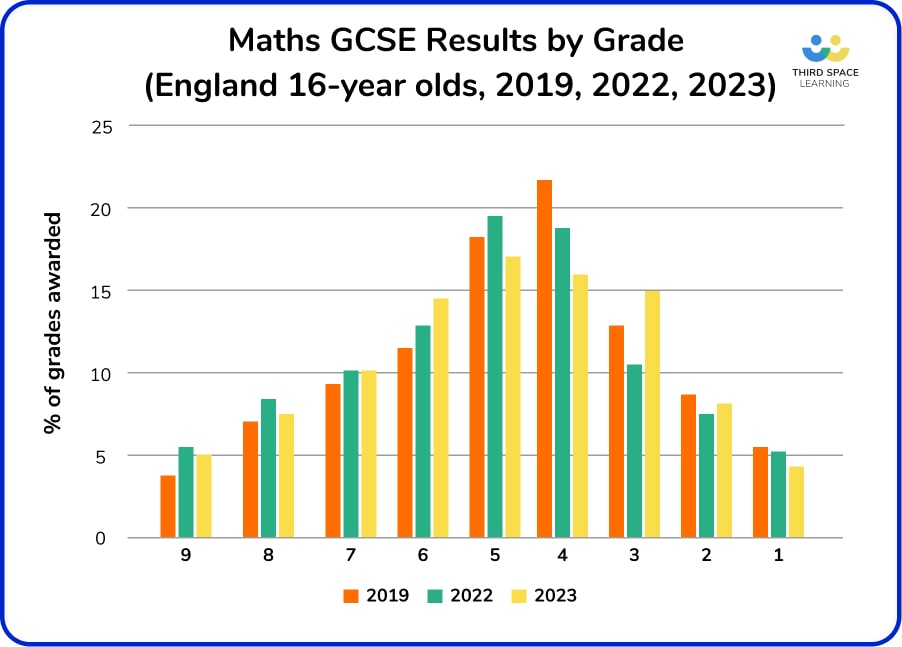
Edexcel GCSE maths results 2023
During 2023’s exam season, I wrote a reflective article after each exam paper, focusing mainly on Edexcel Foundation and Higher.
Read more:
- GCSE Maths Paper 1 2023
- GCSE Maths Paper 2 2023
- GCSE Maths Paper 3 2023
- Summary Of ALL GCSE Maths Papers 2023
My main highlights were as follows:
- Both tiers of papers were generally well-received, with Paper 3 in particular described as “easier”;
- Both tiers had a higher proportion of procedural questions and a lower proportion of multi-step unfamiliar problems when compared to the “average” paper.
Edexcel Higher grade boundaries 2017-2023
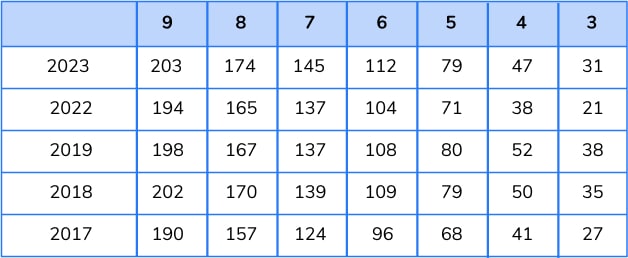
- Boundaries for this year are, on average, nine marks higher than 2022’s exams;
- For grades 6 and above, these boundaries are the highest of any summer series of the reformed GCSE;
- The boundaries for grades 4-5 are in line with pre-2022 exam papers, and the grade 3 boundary is relatively low in comparison with historical data.
Edexcel 2023 Higher grade boundaries by paper

- Boundaries were generally similar across the three Higher papers;
- Paper 3 has slightly higher boundaries, particularly on the lower grades – this may reflect students’ perceptions that the final paper was more straightforward than the other two.
Edexcel Foundation grade boundaries 2017-2023
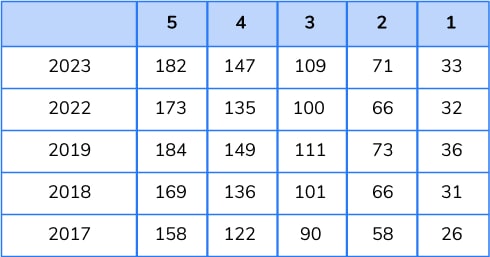
- Boundaries for this year are higher for all grades, but there is some variation;
- The top three grades (3-5) are, on average, ten marks higher than 2022’s exams;
- The greatest increase is on the grade 4 boundary, where students needed an additional 12 marks compared to last year’s papers;
- Grades 1-2 are least impacted by higher grade boundaries this year;
- Generally, grade boundaries are closest to those from 2019.
Edexcel 2023 Foundation grade boundaries by paper
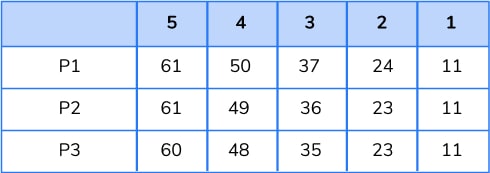
- Boundaries were very similar across all three papers, with very little variation across grades;
- Grade boundaries were actually slightly lower on Paper 3, which was perceived as the easiest at Foundation.
In Third Space Learning’s survey, 66% of teachers found the 2023 GCSE papers more difficult than expected.
How to utilise the GCSE results 2023 data
Once the dust has settled with this year’s cohort and we’ve congratulated, commiserated and applied for re-marks as necessary, September presents an opportune moment to consider any key takeaways from this year that can be applied to the next series of exams.
As we’ve only had two years of summer exams in the previous four, newer members of the teaching profession may have less experience with the process of results analysis.
Bearing this in mind, here are my top tips for what to do with your class’s results!
- Focus on particularly high- and low-performing students. Are there any surprises?
- What is behind any underperformance? Were these students highlighted and targeted earlier during the year?
- Have the interventions your school/department offered been effective?
- Use question-level analysis to identify any whole-class patterns;
- If any borderline scripts are reviewed and re-marked, have a look through these once you’ve received them – even if there is no mark change;
- Some boards offer the option to view scripts electronically (provided you have students’ permission) – this is definitely worth having a look at!
- Use analysis tools provided with your board’s results kit. For example, compare your results to the board average to help you to identify comparative strengths and weaknesses for your students.
When looking at whole-class patterns, there are a few things to look out for.
- Are there any GCSE maths topics that everyone in your class or school has performed poorly on?
- Are these topics ‘expected’? (e.g. we might expect that students aiming for a grade 4 would struggle with a problem that required a double application of Pythagoras and trigonometry);
- If there are any unexpected topics (e.g. students have all done really badly on procedural standard form questions), this may indicate an area for improvement in teaching and learning in the following year;
- What sorts of questions are students struggling with? Can this be supported or targeted in the next year?
When are GCSE 2023 resits?
For students who did not achieve the result they wanted, there is the opportunity to retake GCSE exams. GCSE English and maths resits will take place in November of 2023. Maths resit dates for 2023 are:
- Paper 1 – Wednesday 8th November (AM)
- Paper 2 – Friday 10th November (AM)
- Paper 3 – Monday 13th November (AM)
Resits for other exams will be during the 2023 exam season.
These resits usually take place alongside further education at sixth form colleges or during apprenticeships.
If you’re looking for revision resources for your resit students or for your new Year 10s and 11s, you can find a range of FREE GCSE resources by Third Space Learning, including GCSE worksheets, revision guides, diagnostic questions and more.
In our survey this year, 100% of respondents found Third Space Learning’s GCSE revision resources helpful and 57% found them very helpful.
Maths Teacher, HampshireThe problem-solving questions with ‘hints’ of how to get started were really helpful
Did you know that Third Space Learning creates FREE practice paper packs to support GCSE maths revision each year?
Each set contains three GCSE maths paper: Paper 1 (non-calculator), Paper 2 (calculator) & Paper 3 (calculator). Each set matches the specification of the three most popular GCSE exam boards: Edexcel, AQA and OCR.
Save time by downloading a selection of specially produced practice papers, mark schemes and exam question indexes.
What to expect from GCSEs in summer 2024
In 2023, many exam adaptations were removed, including:
- Fieldwork and science practicals returning to pre-pandemic arrangements;
- A return to full subject content coverage for English literature, history, ancient history and geography;
- A removal of advance information for all subjects.
Formula sheets were retained in maths, physics and combined science for 2023 only. This adaptation continues for the November 2023 resits, but it is assumed that formula sheets will not be available to candidates in summer 2024. However, the DfE didn’t consult on formula sheets for 2023 exams until winter 2022 so if one is to be made available, it is likely that we won’t have this confirmed for some months yet.
With results now close to the levels achieved in 2019, the recent turbulence of results days is hopefully behind us.
However, we must continue to be mindful that the young people sitting exams in 2024 have still experienced significant disruption to learning in the early years of secondary education. In fact, the first cohort who have not had their compulsory schooling affected in some way by the pandemic will not sit GCSEs until summer 2032 – it is likely that we will continue to feel these impacts for years to come.
Further reading:
- Ofqual: Outcomes in England: Interactive graphs and statistics for this year’s GCSE results.
- Ofqual Blog: 10 Things to Know: A handy explainer from Ofqual about the changes to grading in summer 2023.
- JCQ: Results: Results for this year’s GCSE examinations.
- Pearson/Edexcel: Subject Grade Boundaries: The grade boundaries per paper for Edexcel exams in 2023.
- GCSE Grade Boundaries 2022/2023: The New Grading System Explained: A look at how grade boundaries are set for GCSEs from Third Space Learning.
DO YOU HAVE STUDENTS WHO NEED MORE SUPPORT IN MATHS?
Every week Third Space Learning’s specialist GCSE maths tutors support thousands of students across hundreds of schools with weekly online 1 to 1 maths lessons designed to plug gaps and boost progress.
Since 2013 these personalised one to one lessons have helped over 150,000 primary and secondary students become more confident, able mathematicians.
Learn about the GCSE revision programme or request a personalised quote for your school to speak to us about your school’s needs and how we can help.
